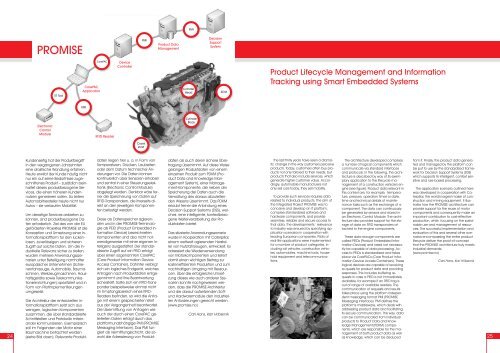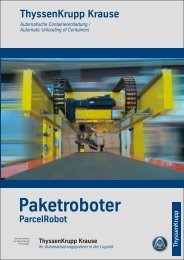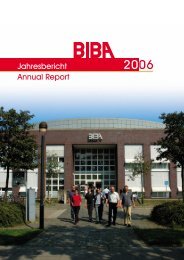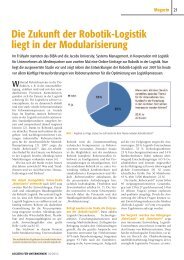W 1 - robotik-logistik.de
W 1 - robotik-logistik.de
W 1 - robotik-logistik.de
Sie wollen auch ein ePaper? Erhöhen Sie die Reichweite Ihrer Titel.
YUMPU macht aus Druck-PDFs automatisch weboptimierte ePaper, die Google liebt.
PROMISE<br />
Electronic<br />
Control<br />
Module<br />
ET Tool<br />
Kun<strong>de</strong>nseitig hat <strong>de</strong>r Produktbegriff<br />
in <strong>de</strong>n vergangenen Jahrzehnten<br />
eine drastische Wandlung erfahren.<br />
Heute erwirbt <strong>de</strong>r Kun<strong>de</strong> häufig nicht<br />
nur ein auf seine Bedürfnisse zugeschnittenes<br />
Produkt – zusätzlich beinhaltet<br />
dieses produktbezogene Services,<br />
die einen höheren Kun<strong>de</strong>nnutzen<br />
generieren sollen. So liefern<br />
Automobilhersteller heute nicht nur<br />
Autos – sie verkaufen Mobilität.<br />
Um <strong>de</strong>rartige Services anbieten zu<br />
können, sind produktbezogene Daten<br />
erfor<strong>de</strong>rlich. Ziel <strong>de</strong>s von <strong>de</strong>r EU<br />
geför<strong>de</strong>rten Projektes PROMISE ist die<br />
Konzeption und Umsetzung einer Informationsplattform<br />
für <strong>de</strong>n lückenlosen,<br />
zuverlässigen und sicheren<br />
Zugriff auf solche Daten. Um die industrielle<br />
Relevanz sicher zu stellen,<br />
wur<strong>de</strong>n mehrere Anwendungsszenarien<br />
unter Beteiligung namhafter<br />
europäischer Unternehmen (Schienenfahrzeuge,<br />
Automobile, Baumaschinen,<br />
Werkzeugmaschinen, Haushaltsgeräte<br />
sowie Telekommunikationseinrichtungen)<br />
spezifiziert und in<br />
Form von Pilotimplementierungen<br />
umgesetzt.<br />
Die Architektur <strong>de</strong>r entwickelten Informationsplattform<br />
setzt sich aus<br />
wenigen, logischen Komponenten<br />
zusammen, die über standardisierte<br />
Schnittstellen und Protokolle miteinan<strong>de</strong>r<br />
kommunizieren. Exemplarisch<br />
soll im Folgen<strong>de</strong>n <strong>de</strong>r Motor einer<br />
Baumaschine betrachtet wer<strong>de</strong>n<br />
(siehe Bild oben). Relevante Produkt-<br />
CorePAC<br />
Application<br />
USB<br />
CorePAC<br />
RFID Rea<strong>de</strong>r<br />
Device<br />
Controller<br />
PMI<br />
Crank<br />
shaft<br />
daten liegen hier u. a. in Form von<br />
Temperaturen, Drücken, Laufzeiten<br />
o<strong>de</strong>r <strong>de</strong>m Datum technischer Än<strong>de</strong>rungen<br />
vor. Die Daten können<br />
kontinuierlich über Sensoren erhoben<br />
und zentral in einer Steuerungselektronik<br />
(Electronic Control Module)<br />
abgelegt wer<strong>de</strong>n. Denkbar wäre ferner<br />
die Speicherung von Daten auf<br />
RFID-Transpon<strong>de</strong>rn, die ihrerseits direkt<br />
an <strong>de</strong>n jeweiligen Komponenten<br />
befestigt wer<strong>de</strong>n.<br />
Diese als Datenspeicher agieren<strong>de</strong>n<br />
und in <strong>de</strong>r PROMISE-Terminologie<br />
als PEID (Product Embed<strong>de</strong>d Information<br />
Device) bezeichneten<br />
Komponenten sind also nicht notwendigerweise<br />
mit einer eigenen Intelligenz<br />
ausgestattet. Der standardisierte<br />
Zugriff auf ein PEID erfolgt<br />
über einen sogenannten CorePAC<br />
(Core Product Information Device<br />
Access Container). Dahinter verbirgt<br />
sich ein logisches Endgerät, welches<br />
Anfragen nach Produktdaten entgegennimmt<br />
und ihre Beantwortung<br />
sicherstellt. Sollte sich ein RFID-Transpon<strong>de</strong>r<br />
beispielsweise einmal nicht<br />
im Empfangsbereich eines RFID-<br />
Rea<strong>de</strong>rs befin<strong>de</strong>n, so wird die Anfrage<br />
mit einem gespeicherten Wert<br />
aus <strong>de</strong>r Vergangenheit beantwortet.<br />
Die Übermittlung von Anfragen wie<br />
auch <strong>de</strong>r durch einen CorePAC gelieferten<br />
Daten erfolgt durch das<br />
plattformunabhängige PMI (PROMISE<br />
Messaging Interface). Das PMI fungiert<br />
als Vermittlungsschicht, die so-<br />
Product Data<br />
Management<br />
PMI<br />
Cylin<strong>de</strong>r<br />
Head<br />
Cylin<strong>de</strong>r<br />
Block<br />
Decision<br />
Support<br />
System<br />
ECM<br />
daten als auch <strong>de</strong>ren sichere Übertragung<br />
übernimmt. Auf diese Weise<br />
gelangen Produktdaten von einem<br />
einzelnen Produkt zum PDKM (Product<br />
Data and Knowledge Management<br />
System), einer Management-Komponente,<br />
die neben <strong>de</strong>r<br />
Speicherung <strong>de</strong>r Daten auch die<br />
Verwaltung <strong>de</strong>s daraus abzuleiten<strong>de</strong>n<br />
Wissens übernimmt. Das PDKM<br />
erlaubt ferner die Anbindung eines<br />
Decision Support Systems (DSS), welches<br />
eine intelligente, kontextbezogene<br />
Weiterverarbeitung <strong>de</strong>r Produktdaten<br />
bietet.<br />
Das skizzierte Anwendungsszenario<br />
wur<strong>de</strong> in Kooperation mit Caterpillar,<br />
einem weltweit agieren<strong>de</strong>n Hersteller<br />
von Nutzfahrzeugen, entwickelt. Es<br />
adressiert die Wie<strong>de</strong>rverwendung<br />
von Motorkomponenten und liefert<br />
damit einen wichtigen Beitrag zur<br />
kosteneffizienten Produktion und zum<br />
nachhaltigen Umgang mit Ressourcen.<br />
Über die erfolgreiche Umsetzung<br />
dieses wie auch an<strong>de</strong>rer Szenarien<br />
konnte nachgewiesen wer<strong>de</strong>n,<br />
dass die PROMISE-Architektur<br />
und die darauf aufsetzen<strong>de</strong>n Soft-<br />
und Hardwaremodule <strong>de</strong>n industriellen<br />
Anfor<strong>de</strong>rungen gerecht wer<strong>de</strong>n.<br />
(www.promise.no)<br />
Carl Hans, Karl Hribernik<br />
Product Lifecycle Management and Information<br />
Tracking using Smart Embed<strong>de</strong>d Systems<br />
The last thirty years have seen a dramatic<br />
change in the way customers perceive<br />
products. Today, customers often buy products<br />
not only tailored to their needs, but<br />
products that also inclu<strong>de</strong> services, which<br />
generate higher customer value. Accordingly,<br />
automobile manufacturers not<br />
only sell cars today, they sell mobility.<br />
To provi<strong>de</strong> such services requires data<br />
related to individual products. The aim of<br />
the Integrated Project PROMISE was to<br />
conceive and <strong>de</strong>velop an IT platform,<br />
comprise standardized software and<br />
hardware components, and provi<strong>de</strong><br />
seamless, reliable and secure access to<br />
that data. The <strong>de</strong>velopments´ relevance<br />
to industry was ensured by specifying application<br />
scenarios in cooperation with<br />
leading European companies. Pilots of<br />
real-life applications were implemented<br />
for a number of product categories, including<br />
rail vehicles, construction vehicles,<br />
automobiles, machine tools, household<br />
equipment and telecommunications.<br />
The architecture <strong>de</strong>veloped comprises<br />
a number of logical components which<br />
communicate via standard interfaces<br />
and protocols. In the following, the architecture<br />
is <strong>de</strong>scribed by way of its exemplary<br />
application to the lifecycle management<br />
of a construction vehicle's engine<br />
(see figure). Product data relevant in<br />
this context are, for example, temperature,<br />
pressure, operation times or date,<br />
time and technical <strong>de</strong>tails of maintenance<br />
tasks such as the exchange of a<br />
component. The data can continuously<br />
be generated by sensors and stored in<br />
an Electronic Control Module. The architecture<br />
also provi<strong>de</strong>s support for the storage<br />
of data on RFID transpon<strong>de</strong>rs attached<br />
to the engine components.<br />
These data storage components are<br />
called PEIDs (Product Embed<strong>de</strong>d Information<br />
Devices) and need not necessarily<br />
be capable of data processing. Access<br />
to PEIDs is standardized and takes<br />
place via CorePACs (Core Product Information<br />
Device Access Containers). These<br />
logical <strong>de</strong>vices are capable of receiving<br />
re-quests for product data and providing<br />
responses. This inclu<strong>de</strong>s buffering requests<br />
in case a PEID is not immediately<br />
available, for example if an RFID tag is<br />
out of range of available rea<strong>de</strong>rs. The<br />
communication of requests and results<br />
takes place using the platform in<strong>de</strong>pen<strong>de</strong>nt<br />
messaging format PMI (PROMISE<br />
Messaging Interface). PMI <strong>de</strong>fines the<br />
platform's middleware, which <strong>de</strong>als with<br />
addressing product data and facilitating<br />
its secure communication. This way, data<br />
can be communicated from individual<br />
products to Product Data and Knowledge<br />
Management (PDKM) components,<br />
which are responsible for the management<br />
of both product data as well<br />
as knowledge, which can be <strong>de</strong>duced<br />
from it. Finally, the product data generated<br />
and managed by the platform can<br />
be put to use by the standardized framework<br />
for Decision Support Systems (DSS)<br />
which supports its intelligent, context sensitive<br />
and rule-based processing.<br />
The application scenario outlined here<br />
was <strong>de</strong>veloped in cooperation with Caterpillar,<br />
the world's largest maker of construction<br />
and mining equipment. It illustrates<br />
how the PROMISE architecture can<br />
provi<strong>de</strong> support for the reuse of motor<br />
components and consequently make an<br />
important contribution to cost-effective<br />
production, while focusing on the sustainable<br />
use and management of resources.<br />
The successful implementation and<br />
evaluation of this and several other scenarios<br />
encompassing the entire product<br />
lifecycle <strong>de</strong>liver the proof-of-concept<br />
that the PROMISE architecture truly meets<br />
industrial <strong>de</strong>mands.<br />
(www.promise.no)<br />
Carl Hans, Karl Hribernik<br />
24 wohl die Adressierung von Produkt-<br />
25









